The islands known as the ‘seven pearls of the Mediterranean’
By Helen Pitt
We are bobbing up and down on a boat in the middle of the Tyrrhenian Sea, having a science lesson about volcanoes from two American high school teachers, when suddenly Stromboli erupts.
It is a sight to behold. White smoke billows skyward from its 926-metre-high peak and our two teachers, Barb Orth and Marian Hoskins, are besides themselves with joy. We all gaze drop-jawed at the cauldron of fire and real brimstone.
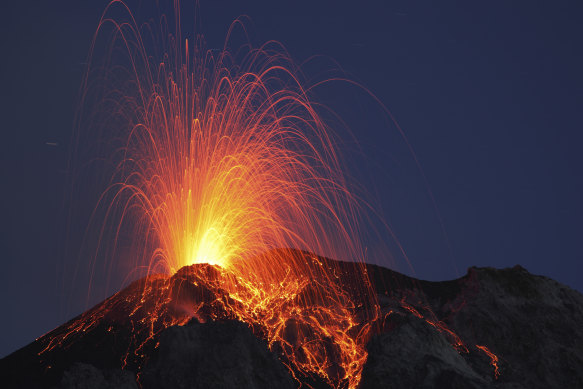
Stromboli is constantly active with minor eruptions.Credit: Getty Images
“Stromboli is like the Holy Grail for science teachers,” says Orth in her delightful Southern twang. “It’s like a Catholic going to the Vatican.”
The rest of us hang off their every word while they point to the yellow line on the volcano, which they call the sulphur line. They explain how hot, quick-flowing magma from deep beneath the Earth’s surface rises, collects in magma chambers and bursts forth to the surface like a giant belch through vents and fissures.
“The molten rock is lighter than the solid rock,” Hoskins says, keeping the intricacies of volcanology simple for us lay folk. “It is known as magma underground and lava when it breaks through the Earth’s surface.”
My high school science teacher lost me at the periodic table. But this duo, who tag-teamed when they taught at Hamilton Central School in upstate New York, explain things in such a fascinating way it makes me wish I’d paid more attention in physics and chemistry classes. Or had them as my teachers.
All I had known about Stromboli, before this moment, was gleaned from the 1950 Italian-American film of the same name, directed by Roberto Rossellini and starring Ingrid Bergman. Their sizzling extramarital affair began here, giving it the moniker “the volcano of love”, which you find still printed on souvenirs over 70 years later. The island is also home to about 500 brave souls who live on its dark volcanic soil.
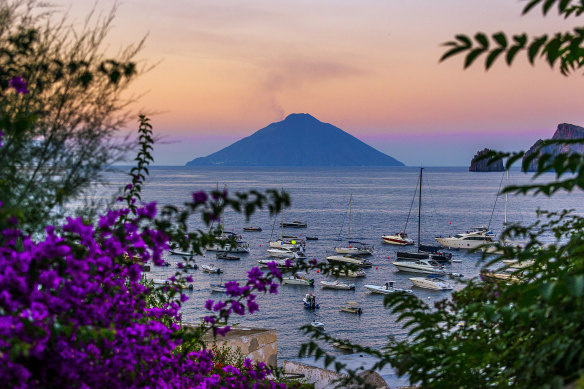
Stromboli is one of Italy’s seven Aeolian islands.Credit: Getty Images
We’ve come to this rocky outcrop, part of the volcanic arc of islands on the north-east Sicilian coast, as part of a Collette tour of Sicily and its isles.
Stromboli is one of Italy’s seven Aeolian Islands, where, the joke goes, the eighth island is Australia.
For much of the 20th century, Aeolians left this archipelago, seeking work and a new life in places like Australia. By 1914, nearly 10,000 Aeolian Islanders – about one-third of the overall population at the time – had emigrated (mostly to the US, but many to Australia too). By 1971, according to the Australian census, there were nearly 290,000 first-generation, Italian-born migrants in Australia, a significant proportion of whom were of Aeolian origin.
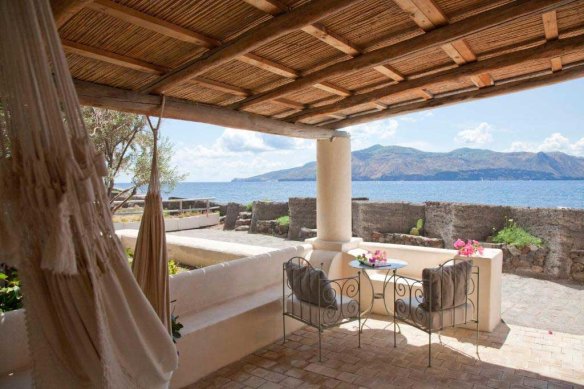
La Salina Hotel Borgo Di Mare, overlooking serene Lingua Lake.
The links with Australia are evident in the accents of some of the locals who have spent time Down Under. When our ferry from Milazzo on the north-east Sicilian coast arrives at the island of Salina, where we stay several nights, an Australian friend who owns a house here arranges to have his local friends meet us at the ferry. Even the owners of the beautiful whitewashed beachfront hotel where we stay at Lingua, La Salina Hotel Borgo Di Mare, spend some of the year in Drummoyne in suburban Sydney.
We’re visiting Stromboli on a day and night trip by boat. It is constantly active with minor eruptions, often visible from many points on the island and from the surrounding Tyrrhenian Sea, giving rise to its nickname, the lighthouse of the Mediterranean.
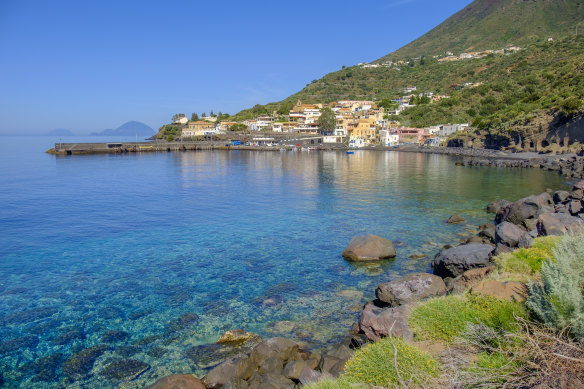
The volcano’s glow is even visible from Salina, the second-largest Aeolian island.Credit: Getty Images
But night is when the real magic occurs. I’ve been lucky enough to witness the glowing embers from afar on my first night in Salina, in the citrus-tree-filled backyard of Australian-born Libby and true Aeolian Santino; strangers when they pick me up at the ferry, but firm friends after a few glasses of their locally grown Malvasia wine.
On the boat the next day, while awaiting evening eruptions on Stromboli, we put down anchor several times on our sunny summer Saturday. A couple of times it is for a quick swim to cool off. I jump into the crystal clear waters but don’t realise I’ve swum into a medusa jelly fish, the Mediterranean equivalent of a blue bottle. It stings. A quick visit to the pharmacy on Panarea, our next island stopover, helps ease the pain.
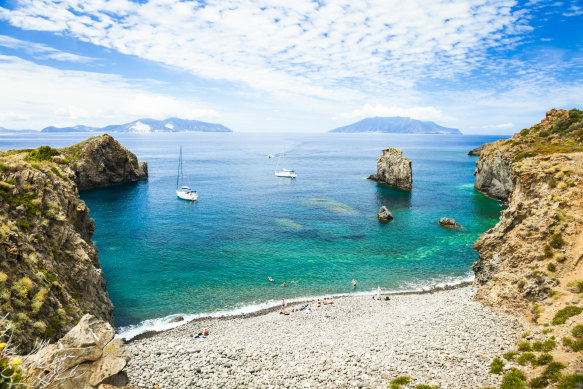
Panarea is the most expensive of all the Aeolian Islands.Credit: Getty Images
All over mainland Sicily, we’d used what we called the Aperol Spritz Index to determine the cost of living in the place we were enjoying our afternoon aperitivo. The standard was €5 ($8), while €7 was normal in touristy places. In Panarea, the Aperols set you back a massive €10, which gives you some idea of the demographic.
Its ritzy bars are packed with well-heeled, if scantily clad (mainly Italian) tourists happily sipping costly cocktails. Most people in Panarea are too cool – and usually too rich – to care about the cost. Fashion designer Giorgio Armani had pulled in a week before us on his $60 million super yacht.
After Panarea we board our boat again, Stromboli-bound, for a stroll around the streets of the town on one of the four active volcanoes in Italy. Vulcano, only 25 kilometres from the Sicilian coast and our first stop on the way to our accommodation in Salina, is another active volcano. Although its last eruption was in 1888-90, you inhale the pungent stench of sulphur even before you arrive. The word volcano is derived from this island, which in turn comes from Vulcan, the god of fire in Roman mythology.
But it is Salina that’s considered the real gem of the islands known as the “seven pearls of the Mediterranean”. It’s where Il Postino, the hypnotically beautiful Italian classic was filmed in 1994, telling the fictional story of exiled Chilean poet Pablo Neruda’s friendship with the local postman.

Vulcano Island is named after Vulcan, the god of fire in Roman mythology.Credit: Getty Images
It is also the caper capital of the world, and at Pollara, near where the film was set, we visit a caper farm, where we dine on a three-course meal with salty capers served in every course, accompanied by sweet Malvasia wine. Caper-and-cream-filled cannolis have a touch of the salted-caramel taste to them – delicious.
Here I see a caper bush and flower for the first time. By day, in the glare of the sun, the flower has no aroma, but at night the delicate white blooms with purple stamens fill the air with scent. Much like the locals, they are creatures of the night.
After one very late Salinan evening, my new friend Santino picks me up early to take me on a tour of his island home. The stunning scenery is best seen cruising in a car on the steep roads that snake around the mountains, with the azure sea way below.
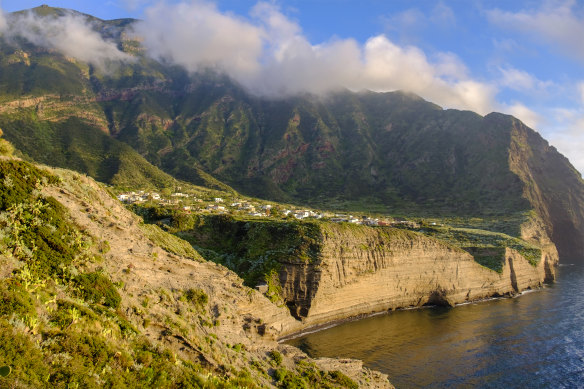
Salina, the second-largest of the Aeolian Islands, is considered the real gem.Credit: Getty Images
The roads are bordered by the native ginestra flower, a stunning yellow that almost matches the colour of Santino’s yellow/mustard pants. Also known as the Mount Etna bloom (after another of Sicily’s active volcanoes), the flowers are as eye-catching as some of the handmade pottery you will find in Salina’s shops (I even found a ceramic Medusa head on one backstreet).
Ceramic Moorish heads sprouting basil adorn balconies all over Sicily, but especially in Salina. Legend has it that around the year 1100 during the Moors’ domination of Sicily, a young woman from Palermo’s Arab quarter fell in love with a visiting Arab who forgot to mention the wife and children he left at home. In a jealous rage, she supposedly cut off his head, and the star-crossed lovers are now immortalised in souvenirs of all varieties all over Sicily.
Back to our science lesson on Stromboli. Before sunset, we have another swim and set in for the night, hoping for some volcanic action. Stromboli does not disappoint. We gaze at the lava erupting like fireworks in the night sky, mesmerised by the majesty, much like watching the flames of an open fire.
“When you travel you learn so much about the world, and yourself,” our tour guide Paola Balzo says before we disembark.
“And volcanoes,” we chorus, nodding in the direction of our science teachers Barb and Marion.
The details
Tour
Collette offers a range of tours to Sicily, including “Sicily and its Isles” (13 days) from $5299 per person; “Old World Sicily and Malta” (13 days), from $6549 per person; and “Southern Italy and Sicily” featuring Taormina, Matera and the Amalfi Coast (11 to 12 days) from $4549 per person. See gocollette.com
Stay
La Salina Hotel Borgo Di Mare overlooks the lighthouse and the small Lingua Lake, which is a halting ground for migratory birds such as pink flamingos. Swim on your own private beach or lounge in the hammock of your whitewashed balcony. Home-cooked breakfasts included. Rooms from €90 ($150), Via Manzoni, 98050 Lingua. See lasalinahotel.com
Fly
Fly to Rome from Sydney/Melbourne with Asiana, Etihad, Emirates, Turkish Airlines or Qatar from $1800. Fly to Palermo from Rome with Alitalia (several flights daily) from $180.
Ferry
There are 13 sailings daily from Milazzo to Salina via two ferry operators, Liberty Lines Fast Ferries and Siremar. Milazzo-Salina ferry timetables change seasonally. Ferries to all Aeolian islands leave from Civitavecchia port (70 kilometres north-west of Rome) or Naples to Palermo. See directferries.com.au
The writer travelled as a guest of Collette.
Sign up for the Traveller newsletter
The latest travel news, tips and inspiration delivered to your inbox. Sign up now.